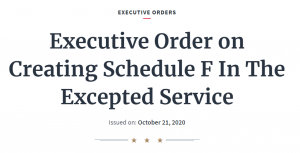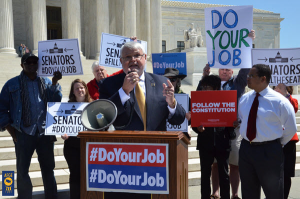Executive Order on Creating Schedule F in the Excepted Service
The federal government is made up of political appointees who serve at the pleasure of the president or agency heads, as well as career federal employees who can only be removed at the end of a lengthy civil service process. The new order will give federal agencies more flexibility and oversight over career federal employees, especially in critical areas that impact policy.
 “The new Schedule F will apply to federal employees serving in confidential, policy-determining, policymaking, or policy-advocating positions that don’t change when a presidential transition occurs”. Cabinet secretaries and federal agency chiefs will work out which employees have a role in writing policy. The agency heads will then submit the list to the Office of Personnel Management for review. They have until Jan. 19 2021, to review potentially affected jobs, then employees from what is known as the "competitive service" — which covers the bulk of the executive branch — will move into the "excepted service," understood as political appointees below the level requiring Senate confirmation.
“The new Schedule F will apply to federal employees serving in confidential, policy-determining, policymaking, or policy-advocating positions that don’t change when a presidential transition occurs”. Cabinet secretaries and federal agency chiefs will work out which employees have a role in writing policy. The agency heads will then submit the list to the Office of Personnel Management for review. They have until Jan. 19 2021, to review potentially affected jobs, then employees from what is known as the "competitive service" — which covers the bulk of the executive branch — will move into the "excepted service," understood as political appointees below the level requiring Senate confirmation.
The executive order addresses a “long-standing complaint—even among federal employees—that poorly performing federal workers aren’t held accountable”. Indeed, a Federal Employee Viewpoint Survey found that only one-third of respondents said proper steps are taken to address poor performers who cannot or will not improve.
According to Rachel Greszler, a research fellow in economics, budget, and entitlements at The Heritage Foundation, the executive order is a “common-sense change to insert some much-needed accountability and could significantly improve the effectiveness of the federal government.”
 Rachel Greszler
Rachel Greszler
She explained this like a situation where a CEO was unable to discipline or fire managers who refused to carry out directives or who took actions that stymied the CEO’s initiatives. “This is the current situation in the federal government, it is near impossible to dismiss federal employees”. She thinks changes laid out in the executive order will produce improvement in managing taxpayers’ money, and might even boost morale in federal workers who are vexed at lack of accountability.
This new order also expands upon President Trump’s 2018 Executive Order (EO) 13839, which has remained after winning several court challenges. EO 13839 set guidelines for reviewing, suspending, and firing federal employees, who would otherwise be able to hang on to a job for months or years after being found to be a poor performer or otherwise not carrying out their duties faithfully.
How the Civil Service Became a Problem/Deep State
When the civil service was created via the 1883 Pendleton Act, the idea had been to create a professional level group of employees who would be non-political and work to implement the policies of the administration holding power. In practice, this worked for some decades and it was mostly successful in preventing an administration from hiring and firing the federal workforce. The problem is having experts continuing in their job from one administration to the next, does not sit well in a reality where holdovers aligned with the Obama White House were not doing their job, on purpose, to damage President Trump. Transparency and perceptions are important, and voters that elected President Trump cite federal employees who were working to influence the 2016 election, who took actions to restrict the newly elected president from being successful, as out of sync with “working for the people.”
Democrats Respond to the Executive Order
Democrats and some mainstream media reporters were infuriated at the news. Journalist Laurie Garrett wrote, “ATTN! While you were sleeping #Trump issued an edict that eliminates job protections for tens of thousands (maybe millions) of federal employees, all involved in policy-making. It paves the way for a mass firing of govt employees.”
Federal labor unions were irate too, saying:
 The American Federation of Government Employees Protest in 2017
The American Federation of Government Employees Protest in 2017
“President Trump has declared war on the professional civil service by giving himself the authority to fill the government with his political cronies who will pledge their unwavering loyalty to him – not to America. By targeting federal workers whose jobs involve government policies, the real-world implications of this order will be disastrous for public health, the environment, the defense of our nation, and virtually every facet of our lives.”
In response to the union’s objections though, an expert on federal human resources Ralph Smith pointed out the irony in the union’s statements, since unions are presently “using their money and resources to elect Democrats to Congress and the White House.”
In fact, Smith says, if Democrats win the White House and Congress, the power and influence of the unions will increase, and they will use this power to elect their political allies. Yet they scold attempts to ‘politicize’ the workforce with this Executive Order or other actions that may work to reduce the influence of federal employee unions.
In Summary
If President Trump is re-elected, the new executive order will be implemented as described on January 19, 2021. It may face a couple of legal challenges, as the 2018 Executive Order on labor and employee relations issues did, but as it stands now, it looks like President Trump is preparing to materially rebuild the federal civil service system in a second term.


